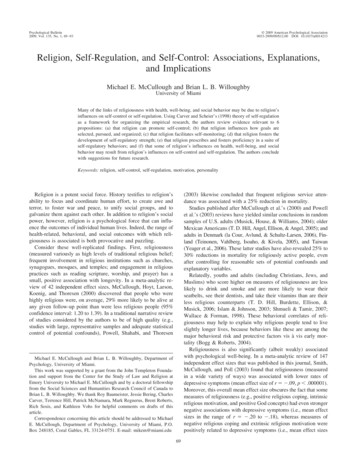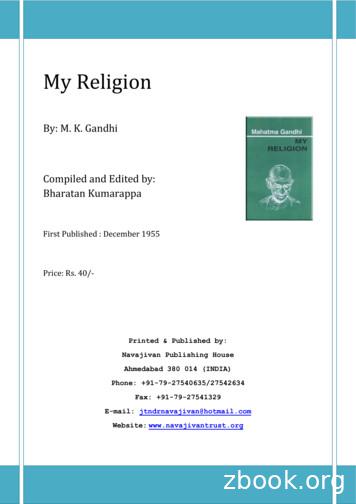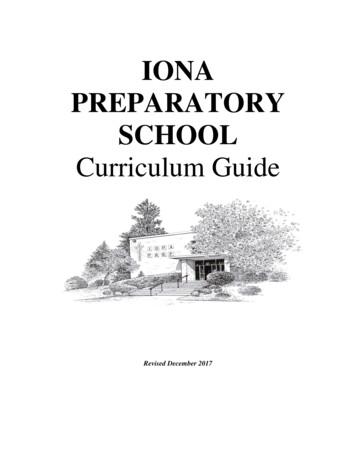Social Institutions: Education And Religion
Education and ReligionSocial Institutions:Education and ReligionWhat if good institutions were in fact the product of goodintentions? What if the cynicism that is supposed to be rigorand the acquisitiveness that is supposed to be realism aremaking us forget the origins of the greatness we lay claim to.Marilynne Robinson
Education and ReligionSocial InstitutionsA social institution is a complex, integrated setof social norms organized around thepreservation of basic societal values.They support the society's survival.While societies may differ in how they establishthese institutions and in how simple or complexthey are, we find the same five basic socialinstitutions among all human groups.
Education and ReligionThe 5 Basic Social Institutionsproduce, distributeand consumegoods and servicesprovide and maintaina sense of purposeGovtEconomyEducationmaintain ordersocialization andlearningReligionFamilyprocreationAlthough all sociologists agree on the big five, many consider othersegments of society to be social institutions as well – aging, themedia, health care, social welfare, work, gender and others.
Education and ReligionGeneral Functions of Social InstitutionsSimplify social behavior for the individual Provide ready-made forms of social relationsand social roles for the individual Act as agencies of coordination and stabilityfor the total culture Control behavior
Education and ReligionSOCIAL INSTITUTIONS:EDUCATION
Education and ReligionDefining Education Asociety’s future largely depends on thesuccessful socialization of new members. Every society develops a system of educationconsisting of the roles and norms that ensure thetransmission of knowledge, values and patterns ofbehavior from one generation to the next. In some preindustrial societies, education is largelyinformal and occurs mainly within the family. Schooling is formal education, which involvesinstruction by specially trained teachers whofollow officially recognized policies.
Education and ReligionDefining Education Functionalistview: Studies the ways in whicheducation aids society Conflictview: Studies the ways in whicheducation maintains the imbalance of power insociety Interactionsview: Studies the face-to-faceinteraction of the classroom.
Education and ReligionThe Purpose of Educationto transmit the knowledge, skills, behaviorpatterns and values necessary for people tobecome functioning members of society
Education and ReligionThe Functionalist Perspective onEducation TeachingKnowledge and Skills Children must learn the knowledge and skills theywill need as adults. Education generates new knowledge, which isuseful in adapting to changing conditions. Transmission of Culture For societies to survive, they must pass on corevalues of their culture. Societiesuse education to support theircommunities’ social and political system.
Education and ReligionThe Functionalist Perspective onEducation SocialIntegration Educationserves to produce a society ofindividuals who share a common national identity. Schools foster social integration and national unityby teaching a core set of skills and values. Occupational Placement Education screens and selects the members ofsociety for the work they will do as adults. Schools in industrialized countries identify studentswho show special talents and abilities at an earlyage.
Education and ReligionThe Conflict Perspective onEducationReinforce inequality Education serves to sort students into social ranksand to limit the potential of certain individuals andgroups to gain power and social rewards. Students’ achievement or failure tend to reflectexisting inequalities. Tracking Tracking -- Involves the assignment of students todifferent types of educational programs Classroom instructions used in the different tracksserve to reproduce the status quo.
Education and ReligionThe Conflict Perspective onEducation SocialControl Schools produce unquestioning citizens who acceptthe basic inequalities of the social system. Hidden curriculum -- Schools’ transmission ofcultural goals that are not openly acknowledged. Education and Socioeconomic Status Opportunitiesfor educational success aredistributed unequally. Higher-status college students outnumber lowerstatus college students.
Education and ReligionThe Conflict Perspective onEducation
Education and ReligionThe Interactionist Perspective onEducation Student-TeacherInteraction Students labeled fast learners or slow learnerswithout any data eventually took on thecharacteristics of the label. A self-fulfilling prophecy is a prediction that leadsto behavior that makes the prediction come true. When teachers treat students as if they are brightand capable, students begin to think of themselvesin this way and vice versa.
Education and ReligionThe Interactionist Perspective onEducation Interactionsamong Students TheColemanReportfound thatthesocioeconomic status of fellow students was themost significant factor in explaining studentsuccess. Peer pressure may be a factor in this dynamic.
Education and ReligionThe Self-Fulfilling ProphecyStudents tend toaccept the labelsteachers place on themand behave accordingly.The students’ behaviorthen confirms theteachers’ originalexpectations.
Education and ReligionHow do we learn what it means to beAmerican?
Education and ReligionPerspectives on EducationUnder whichperspective doyou think PinkFloyd’s JustAnother Brick inthe Wall would fit?
Education and ReligionEducational Reform Historyof Reform In the early part of the 1900s education concernscentered on the assimilation of immigrants. In the mid-1900s Americans looked to educationto win the space race. After 1983 education focused on comparingAmerican students to those in other nations. Althoughmany overhauls occurred, reformsbrought little progress. The improvement goals originally planned for 2000were not met.
Education and ReligionEducational Reform No Child Left Behind2001 law with benchmarks for improving schools.Provided money for schools to improve teaching.Made standardized test scores the measure of how aschool was performing.Extra emphasis on early reading instruction andteacher preparation.Although test scores have risen, some claim thathigher-order thinking skills have been neglected.
Education and ReligionEducational Reform
Education and ReligionThe Purposes Behind EducationReform Since the 1980simprove student achievement, preparation forjobs in the age of information technology
Education and ReligionAlternatives to Public Schools Charterschools: Funded with public money butprivately operated and run. The charter establishesthe amount of public funding the school receives. School choice: Parents may receive a voucherequal to the amount their state spends on educationfor their child that they can put toward the tuition ata private, charter or religious school. Homeschooling: A system in which a child’s maineducation is by parents at home. Critics ofhomeschooling claim that it may not provide a broadenough curriculum or necessary social interaction.
Education and ReligionViolence in Schools A2006 survey showed that only 75% of parents believed theirpublic schools were “very” or “somewhat” safe. Such fears are generated by violent incidents such as theColumbine High School shootings. In 2005 about 10% of boys and 3% of girls were threatened orinjured by a weapon at school. Schools seem to be safer for students than being off campus. Zero tolerance policies involve set punishments—oftenexpulsion—and no leniency for serious offenses such ascarrying a weapon, committing a violent act or possessingdrugs or alcohol. Some educators believe that the best way to curb schoolviolence is to teach young people how to resolve disputespeacefully.
Education and ReligionMaking Schools Safe14% of grades 9-12 students have been involvedin a physical fight at school. 28% of students have experienced verbal orphysical bullying at school in the last 6 months. 86% of high schools reported a theft in the lastschool year. 85% of public schools control access to schoolbuildings. 43% of public schools use security cameras. 2% of public schools require students to passthrough metal detectors daily.
Education and ReligionEnglish as a Second Language Bilingualeducation -- a system in which non-Englishspeaking students study science, math and othersubjects in their native languages until they gain fluencyin English. Bilingual education has had the support of manyeducators, but the plan has been opposed by those whobelieve that it interferes with cultural assimilation. In 1998 a citizens’ initiative made bilingual educationillegal in California. As of 2008, 30 states have laws making English theirofficially recognized language.
Education and ReligionAlternative EducationInterest in alternative schooling methods has ledto three distinctive styles of alternativeschooling: the free school movement, magnetschools and back-to-basics curricula.
Education and ReligionAlternative Education Freeschool: Schools should encourage creativity byallowing students to learn through exploration andexperimentation. Magnet school: Schools with distinct features intendedto attract students from across a district. Back-to-basics curricula: Programs are designed toprepare failing or at-risk students for their return tomainstream schools. First two types designed as a way to change schooling,third type designed as a substitute. Some longtime supporters are concerned that thethird style has become dominant.
Education and ReligionCase Study: Religion in PublicSchoolsParents have the primary responsibility of caring for theirchildren and they often share religious worship with theirchildren.By common belief, failing to educate a child to fully participatein society constitutes harm, so the government requireschildren to attend school.What happens when the government attempts to teachlessons that parents or students object to on religiousgrounds? The First Amendment clearly states that thegovernment will not create a state religion but court judgesare in charge of the interpretation in specific cases. Courtcases have resulted in the banning of voluntary prayer times.
Education and ReligionUS Supreme Court Rulings on Prayerin Public Schools
Education and ReligionSOCIAL INSTITUTIONS:RELIGION
Education and ReligionReligion—A SociologicalDefinition Societiesmake distinctions between the sacred (anythingthat is considered to be part of the supernatural worldand that inspires awe, respect, and reverence) and theprofane (anything considered to be part of the ordinaryworld and, thus, commonplace and familiar). This distinction is the basis for of all religions (systems ofroles and norms that are organized around the sacredrealm and that bind people together in social groups). Religion is a basic institution, yet it exists in many differentforms because different societies give sacred meaning to awide variety of objects, events, and experiences.
Education and ReligionThe Functions of Religion SocialCohesion Strengthens bonds between people. Can lead to conflict between adherents of different religions. Social Control Encourages conformity to norms. Provides a divine purpose for conformity. May inhibit innovation, freedom of thought and social reform. Emotional Support Helps people endure disappointment and suffering by providing acomfort in believing that harsh circumstances have a specialpurpose. Attempts to provide answers to the questions concerning lifeand death.
Education and ReligionThe Nature of Religion Rituals and SymbolsRitual -- An established pattern of behavior throughwhich a group of believers experiences the sacredOften used to mark changes in status such as birth,marriage and death.Also used to unite believers and reinforce faith.Often includes sacred symbolic objects—such asclothing, herbs, chalices, or books.
Education and ReligionThe Nature of Religion Belief SystemsAnimism: Belief that spirits actively influence human life;two kinds: shamanism and totemismTheism: Belief in god or gods; two kinds: monotheism andpolytheismMonotheism: The belief in one god, who is usually seen asthe creator and moral authorityPolytheism: Belief in a number of godsEthicalism: The idea that moral principles have a sacredquality
Education and ReligionThe Nature of Religion OrganizationalStructures Ecclesia -- Structured bureaucratic organization, closelyallied with the government, whose officials are highlytrained and wield considerable power Denomination -- Well-established religious organizationin which a substantial number of the population aremembers Sect -- Relatively small religious organization thattypically has split off from a denomination because ofdifferences concerning beliefs Cult -- New religion whose beliefs differ markedlyfrom those of the society’s major religions
Education and ReligionAcceptance of Religious Organizations
Education and ReligionReligion in the United States Freedomof religion is protected by law and supported by popularopinion. TheUnited States is home to hundreds of religiousdenominations, sects and cults. Immigrants often bring new religions. Separation of church and state means the US has no nationalreligion. Most Americans belong to one of the major faiths, with the majoritybeing Protestant Christians. Demographic differences amongreligious groups exist. The general opinion in the US is that all people should hold somereligious beliefs. Rise of fundamentalist Christianity has become a topic of study.
Education and ReligionReligion in the United States
Education and ReligionReligious Participation Although the majority of Americans claim a religiouspreference, only about one-third of people attendreligious services on a regular basis.Secular refers to the non-religious aspects of society Decisions based equally on religious teaching and ownbeliefsReligiosity is the depth of people’s religious feelings. Hard to measure Depth of feeling does not correlate with participationin services.
Education and ReligionFundamentalist ChristianityReligious fundamentalism refers to a set of associated beliefs including strictadherence to the religion’s rules and practices and the belief that religionshould be the primary force in one’s life. A variety of fundamentalist Christian groups exist in the United States, butthey share the beliefs that: the Christian Bible is completely and literally true. Jesus Christ is divine. their faith will bring personal salvation—the “born-again” experience. they are obligated to bring Jesus Christ into the lives of allnonbelievers. 26% of Americans describe themselves as “born-again” or evangelicalChristians. These Americans have become politically organized around certain issuessuch as opposition to abortion and homosexuality.
Education and ReligionCultural Diversity and Sociology Christianity:Protestants firstarrived in the 1600s and thecountry is today predominantlyChristian. Buddhism: Chinese immigrantsbrought Buddhism during themid-1800s and many non-AsianAmericans have adopted it. Hinduism: Born in the ancientIndus Valley, today there aremore than one million Hindusin the United States. Judaism:Founded about 2000BC and practiced by 5 millionAmericans,anumbercomparable to the Jewishpopulation of Israel. Islam: The religion of Muslims;there are more than 4.7 millionMuslims in the United States. Other Religions: Sikhism, Baha’i,Taoism, Spiritualism and diverseNative American and New Agefaiths; 34 million claim noreligion and more than 1million are atheists.
Education and ReligionReligion in the United States
Education and ReligionCultural Diversity and SociologyWhat effect has immigration had on religiousdiversity in the United States?In what ways does the religious diversity of theUnited States affect society?
Education and Religion
Education and Religion The 5 Basic Social Institutions Govt Economy Education Religion Family Although all sociologists agree on the big five, many consider other segments of society to be social institutions as well – aging, the media, health care, social welfare, work, gender and ot
FAMILY AND RELIGIOUS STUDIES SYLLABUS (FORMS 1 – 4) 9 Religion and the Liberation Struggle-Chimurenga/Umvukela Religion, Rights and Social Responsibility Religion and Conflict management 7.0 SCOPE AND SEQUENCE 7.1 TOPIC 1: RELIGION SUB-TOPIC FOR M 1 FORM 2 FORM 3 FORM 4 Concept of Religion Definition, types and c haracteristics of religion Different religions in Zimbabwe .
Keywords: religion, self-control, self-regulation, motivation, personality Religion is a potent social force. History testifies to religion s ability to focus and coordinate human effort, to create awe and terror, to foster war and peace, to unify social groups, and to galvanize them against each other. In addition to religion s social
religion. However, religion cannot be defined except by the characteristics by which are found wherever religion itself is found.4 Nevertheless, the one aspect of religion that must be agreed upon, and is required to remotely be considered as religion, is that it is a belief system held by a group of
Religion which takes no account of practical affairs and does not help to solve them, is no religion. Young India, 7-5-'25, p. 164 Every activity of a man of religion must be derived from his religion, because religion means being bound to God,
Religion in the Schools Task Force guided this initiative.6 Overview of Guidelines Part One addresses why it is important to teach about religion, and Part Two outlines ways to teach about religion in constitutionally sound ways. Part Three is an overview of approaches to teaching about religion
Curriculum Guide Revised December 2017. Course Offerings Department 9th 10th 11th 12th Religion Religion 1 Religion 2 Religion 3 Religion 4 Religion 4/ Leadership . Freshmen will become familiar with the Common Application to understand the elements considered by colleges for admission.
The relationship between religion and social cohesion is deeply contextual and constantly evolving. Religion is a social arena that is highly interactive in relationship to other social cleavages. The globalization of religion and the emergence of transnational religious communities affect the dynamics of local social cohesion.
Korean language training. In recent decades the number of KFL textbooks for English-speaking KFL classroom use has steadily increased. However, the number of KFL study materials intended for a self-study purpose is still relatively scarce. Furthermore, to date there has been no published KFL grammar workbook that specifically aims at providing supplemental grammar explanations and exercises in .























